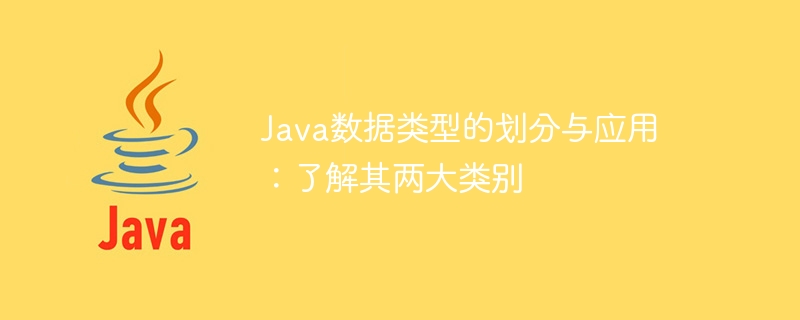

The division and application of Java data types: To understand its two major categories, specific code examples are required
As an object-oriented programming language, Java provides a wealth of Data types used to store and manipulate data. These data types can be divided into two broad categories based on their characteristics and uses: basic data types and reference data types.
Basic data types are the most basic data types in Java. They are primitive, fixed-size data types used to store simple values. Java provides 8 basic data types, namely byte, short, int, long, float, double, boolean and char.
byte, short, int and long are integer types used to store integer values. The difference lies in the representable range and the amount of storage space occupied. For example, the byte type can store integers ranging from -128 to 127, occupying 8 bits of storage space, while the long type can store a larger range of integers, occupying 64 bits of storage space.
float and double are floating point number types, used to store values with decimal parts. They differ in accuracy and the amount of storage space they occupy. The float type can store floating point numbers with approximately 7 significant digits, occupying 32 bits of storage space, while the double type can store floating point numbers with approximately 15 significant digits, occupying 64 bits of storage space.
The boolean type is used to store Boolean values, that is, true or false. It is usually used in control flow and conditional judgment statements.
The char type is used to store a single character. Because Java uses the Unicode character set to represent characters, the char type can represent characters in various languages.
In addition to basic data types, Java also provides reference data types, which are complex data types used to store references to objects. Common reference data types include classes, interfaces, arrays, etc.
Class is the most basic reference data type in Java and is used to create objects. Classes define the properties and behaviors of objects and provide methods for operating these properties and behaviors.
An interface is a special class that defines a set of methods but has no specific implementation. It is used to implement polymorphism and abstraction, allowing different classes to implement the same interface.
An array is a reference data type that can store multiple elements of the same type. It provides methods to access and manipulate array elements. The length of an array is determined when it is created and cannot be changed.
Next, we use specific code examples to demonstrate the application of basic data types and reference data types.
First, let’s look at an example of basic data types:
public class PrimitiveDataTypeExample {
public static void main(String[] args) {
int num1 = 10;
double num2 = 3.14;
boolean flag = true;
char ch = 'A';
System.out.println("num1: " + num1);
System.out.println("num2: " + num2);
System.out.println("flag: " + flag);
System.out.println("ch: " + ch);
}
}The above code demonstrates the declaration and initialization of basic data types, and how to use them to perform basic operations and output results.
Next, let’s look at an example about reference data types:
public class ReferenceDataTypeExample {
public static void main(String[] args) {
String str1 = "Hello";
String str2 = new String("World");
System.out.println("str1: " + str1);
System.out.println("str2: " + str2);
}
}The above code demonstrates the declaration and initialization of reference data types, and how to use the String class to create string objects and output result.
Through the above examples, we can have a deep understanding of the usage and characteristics of basic data types and reference data types. Primitive data types are used to store simple numerical values, while reference data types are used to store references to objects. In actual programming, we need to choose the appropriate data type according to specific needs in order to store and operate data correctly.
Java provides a wealth of data types, which can meet various data storage and operation needs. When writing Java programs, we need to choose the appropriate data type according to the specific situation, and be good at using the functions and methods it provides to process data to achieve the functions and effects of the program.
The above is the detailed content of Classification and uses of Java data types: Master their two main categories. For more information, please follow other related articles on the PHP Chinese website!
 How to solve discuz database error
How to solve discuz database error
 latex usage
latex usage
 What are the search sites?
What are the search sites?
 The difference between windows hibernation and sleep
The difference between windows hibernation and sleep
 Dynamic link library initialization routine failed
Dynamic link library initialization routine failed
 How to check ports in Linux
How to check ports in Linux
 Why can't the Himalayan connect to the Internet?
Why can't the Himalayan connect to the Internet?
 Introduction to the main work content of the backend
Introduction to the main work content of the backend
 How to close the window opened by window.open
How to close the window opened by window.open




